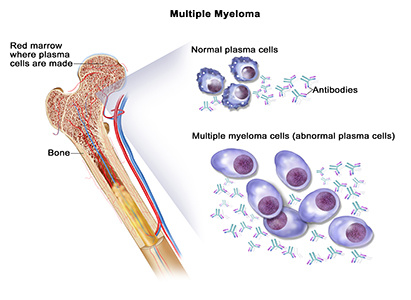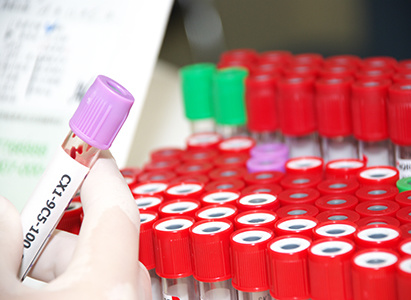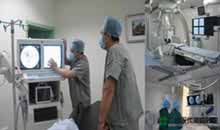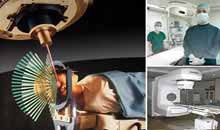- Basic
- Symptoms
- Diagnosis
- Treatments

What Is Multiple Myeloma?
Multiple myeloma refers to a malignant tumor in hematological system, originating from plasma cells (a type of white blood cell generated in the bone marrow). Normal plasma cell is responsible for producing antibodies which can fight against infection, while malignant plasma cell---- myeloma cell proliferates in great numbers in the bone marrow, resulting in disorder of patients’ life, caused symptoms such as anemia, bone pain, fracture, decreased immunity, hypercalcemia, proteinuria, renal inadequacy, etc.
Incidence of Multiple Myeloma
Every year, there are about two out of ten thousand people diagnosed with multiple myeloma which is believed to be the second common malignant tumors arising from blood. It is more commonly seen in the elderly and 50-65 years old is the high incidence age, but age of onset trends to be younger in recent years. Men have higher incidence of multiple myeloma than women, and the ratio is 1.6:1. With age increasing, the incidence of multiple myeloma can also rise, which has brought more and more harm to people’s lives and their quality of life, thus multiple myeloma has become a malignant hematological tumor that old people cannot neglect. Besides, the occurrence of multiple myeloma has certain relation to race, which indicates that the incidence for black people is slightly higher.
Causes of Multiple Myeloma
It is still not clear what cause multiple myeloma, but it may be related to ionizing radiation, chronic antigenic stimulation, herpes virus infections associated with EB virus or Kaposi's sarcoma. In addition, it may also be associated with a number of cell factors, for example IL-6 which is the growth factor of multiple myeloma.
Family Nursing Methods for Multiple Myeloma
1. Rest: patients can do appropriate activities, but never do strenuous exercise, preventing falls and bruise.
2. Bed: in order to prevent pathologic fracture, patient should sleep on the hard bed, so elastic bed should be avoided to use.
3. Diet: food should be high in protein, rich in vitamins and digestible. Patients with renal dysfunction should be given low sodium, low protein diet, in order to reduce the burden on the kidneys. If hyperuricemia and hypercalcemia occur, patients should be encouraged to drink more water and daily urinary volume should be maintained above 2000ml, so as to alleviate their clinical symptoms.
4. Mental guide: giving patients more love and care, helping them face up to reality, alleviating their anxieties, encouraging them to face their conditions positively.
What kinds of supports can be obtained?
Practice proves that the clinic team services composed by multiple disciplines like oncosurgery, oncology, pathology, imageology and anesthesia doctors as well as professional nurses, can provide patients with most effective, most suitable and most economic treatment plan, and also can greatly improve the therapeutic effect of treating cancer patients.
“One station” medical system constructed by Modern Cancer Hospital Guangzhou combining multiple disciplines, can perform comprehensive diagnosis and treatment for patients under the condition of without adding patients’ burden. Therefore, on one hand, it can provide all-round and heartfelt medical services, and on the other hand, it improves medical efficiency and level. There are many channels can be applied to conduct the communication between patients and doctors, like online consultation, email, telephone conversation, and face-to-face consultation. All these consultation services can effectively help patients to fight the cancer. While the medical team faced by the patients includes doctors, nurses, dietitians, interpreters and so on to meet various demands in different level of different countries. Patients would be more confident under the unobstructed communication environment to cooperate the hospital to diagnose and treat the diseases.

Multiple myeloma (MM) is a cancer of plasma cells from B lymphocytes. Multiple myeloma generally has no obvious symptoms in the early stage, so what are the symptoms of multiple myeloma?
1. Bone pain: it is a main symptom. Bone pain most commonly involves the spine and vertebrae, and then ribs. It is manifested as intermittent pain in the beginning, gradually becomes persistent pain, and worsens with activity.
2. Infection: repeated infection is often caused, often occurring in the lung, urinary system, skin, sinus, etc. It is more common in the advanced stage or in the process that chemotherapy is undergone, manifests as intractable infection, not easy to be controlled with medication, so it often becomes the main cause of death.
3. Anemia: it results from the damage of hemopoietic system by infiltrating tumor cells and inhibition of normal red blood cell production. Almost all patients have different degree of anemia.
4. Renal dysfunction: it usually occurs in the early stage and about 20% of patients develop renal dysfunction, causing uremia which leads to death.
5. Immunoglobulin abnormality: a large number of monoclonal immunoglobulin makeas the viscosity of blood increase, resulting in slowing of blood flow and microcirculation disorder. These kinds of patients will develop errhysis of capillary or bleeding, numbness of limbs, cerebral dysfunction, etc.
6. Neurological symptoms: when tumor infiltrates or compresses nerves, spinal cord and other parts, there will be corresponding symptoms appearing, such as paralysis, urinary retention, neuropathic pain, numbness of limbs and movement disorders, etc.
7. Other symptoms: such as high calcium deficiency, hepatosplenomegaly (enlargement of liver and spleen), amyloidosis (AL), a few patients with cryoglobulinemia will develop secondary Reynaud’s phenomenon.
Experts from Modern Cancer Hospital Guangzhou remind you that if found suspected symptoms of multiple myeloma, you should go to hospital for examination and treatment immediately.

The diagnosis of MULTIPLE MYELOMA is based upon the presence of characteristic signs and symptoms of the disease and on the results of tests of the blood and bone marrow. Several tests are used to determine the presence and severity of MULTIPLE MYELOMA. In some individuals with early MULTIPLE MYELOMA or related conditions, it may be necessary to repeat these tests periodically until the diagnosis is certain.
Oncologist from Modern Cancer Hospital Guangzhou explains that after MULTIPLE MYELOMA is confirmed, additional tests are used to check for the presence of impaired kidney function, anemia, thickening of the blood, and other complications of multiple myeloma.
Blood and urine tests for monoclonal protein — An abnormal protein produced by the plasma cells, called a monoclonal (M) protein (sometimes called a "paraprotein"), can be found in the blood or urine of almost all patients with MULTIPLE MYELOMA, which helps establish the diagnosis. M proteins serve no useful function, and may be responsible for increases in the thickness of the blood, kidney damage, or bleeding problems. In some patients, "free light chains" (FLCs), which represent a small portion of the paraprotein, are secreted either in addition to the M protein or by itself. These can be measured by an assay called the free light chain assay. The assay measures the two types of free light chains, kappa and lambda, which are made by plasma cells, and provides a ratio of the two.
However, doctor of Modern Cancer Hospital Guangzhou says that it is important to remember that not everyone with a monoclonal protein has MULTIPLE MYELOMA. The diagnosis also requires one or more abnormalities such as anemia, bone lesions, kidney failure, or high calcium levels in the blood.
Bone marrow examination — In most individuals with MULTIPLE MYELOMA, a bone marrow aspiration and biopsy (a collection of a small sample of bone marrow for laboratory analysis, usually taken from the hip) shows that plasma cells comprise an abnormally high percentage of bone marrow cells (more than 10 percent). It may be necessary to collect samples from different areas because MULTIPLE MYELOMA can affect the marrow of some bones but not others.
Imaging — In about 80 percent of individuals, routine x-rays show distinct, round (lytic) areas of bone erosion; generalized thinning of the bones; and/or fractures at the time of diagnosis. The bones most comultiple myelomaonly involved are the vertebrae, the ribs, the pelvic bones, and the bones of the thigh and upper arm.
In some people, such as those with bone pain but normal x-rays, other imaging tests may be done. These may include magnetic resonance imaging (MRI), computerized tomography (CT), or positron emission tomography (PET).
Genetic and chromosomal tests — Specialized tests may reveal genetic or chromosomal abnormalities of the plasma cells in individuals with MULTIPLE MYELOMA. The results of these tests are helpful for predicting the response to treatment and survival.
Oncologist from Modern Cancer Hospital Guangzhou further explains the criteria for diagnosis of multiple myeloma which are as follow:
A bone marrow aspirate or biopsy showing that at least 10 percent of the cells are plasma cells or the presence of a plasma cell tumor (called a plasmacytoma), plus at least one of the following two features:
•Evidence of damage to the body as a result of the plasma cell growth, such as severe bone damage, kidney failure, anemia, or high calcium in the blood, and/or
•Detection of one of the following findings: ≥60 percent plasma cells in the bone marrow; free light chain ratio of 100 or more (provided involved FLC level is at least 100 mg/L); or MRI showing more than one lesion (involving bone or bone marrow).

Treatment for multiple myeloma focuses on control. Multiple myeloma patients with stable symptoms do not need treatment but regular follow-up observations, while those who have progressive rise of M protein in blood or urine, or have clinical symptoms, should undergo treatment. Patients less than 70 years old should undergo hematopoietic stem cell transplantation if conditions permitted. For most multiple myeloma patients who have been effectively treated, the M protein and other major index will be stable in a certain time, which is called the platform period. In this case, the patient can undergo immunotherapy and needs dynamic observation, etc.
What are the treatment methods of multiple myeloma?
1. Traditional chemotherapy: usage of chemical synthetic drug in treating disease. Chemotherapy is the use of chemicals to kill tumor cells and inhibit its growth and reproduction, as well as promote its differentiation. It is a kind of systemic treatment method, which has therapeutic effect on the primary lesion, metastases and subclinical metastases. The integrated use of combination chemotherapy helps to enhance the treatment effect
2. Biological Immunotherapy
Immunotherapy is a kind of tumor biological treatment. It includes immunocyte therapy and medicine treatment. Immunotherapy is a treatment method to stimulate the body's own immune system to resist cancer. One of its ways is to give the patient directly with some immune preparation, such as interferon and interleukin-2, etc.
⑴ Interferon: alpha interferon can improve the chemotherapy complete response rate and prolong the disease-free survival rate.
⑵ Interleukin-2: mainly used to remove residual lesions
3.Hematopoietic stem cell transplantation
Patients under 50 years old should actively undergo hematopoietic stem cell transplantation; and patients between 50-70 years old should take into consideration in processing, in principle, should have it to the greatest extent. Hematopoietic stem cell transplantation is not suitable for patients more than 70 years old.
⑴ Autologous hematopoietic stem cell transplantation: it is a great step of multiple myeloma treatment progress. Its treatment effect is obviously better than that of conventional chemotherapy. Moreover, the effect of second transplant is even better. Feasible autologous peripheral blood hematopoietic stem cell transplantation is easy to operate and fast in hematopoietic recovery, thus, has been widely used.
⑵ Allogeneic hematopoietic stem cell transplantation: can greatly improve the treatment effect and is mainly used to young patients who have suitable providers.
4.Targeted therapy
Targeted drugs are the most advanced medicine in the cancer treatment. It inhibits the growth of cancer cells by affecting the specific molecular targets necessary for cancer growth. Targeted drug treatment is to make the drugs aim at the tumor site, so as to save relatively high concentration in local and prolong the drug time. Thus, the tumor destruction is improved, while the normal tissue cells are less affected.
If you have any questions, please contact us via online consultation, email or phone call. If you find our website useful, please follow our FaceBook and YouTube, health information will be updated regularly.




























